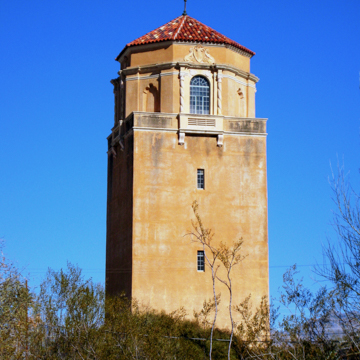You are here
El Conquistador Water Tower
One of the most prominent features of Colonia Solana is the El Conquistador Water Tower (commonly referred to as “El Con”), now a City of Tucson Historic Landmark. Developer Martin Schwerin built El Con in 1928 to serve the new subdivision of Colonia Solana. Four years later, architect Roy Place designed the tower “sheathing” that stands today, enclosing the metal frame and masking the 50,000 gallon tank, thus transforming necessary infrastructure into an ornamental pendant for this elegant housing development. The tower was also intended to draw attention to Colonia Solana to promote sales of lots and houses. (The tower was not associated with the El Conquistador Resort Hotel that was located directly across Broadway Boulevard. The tower only provided water service to the Colonia Solana neighborhood and did not service the hotel.)
The east and west facades of the 90-foot tower are unbroken planes of stucco; on the north and south facades are three small windows running up the tower above large entry doors. These are capped by elaborate bas‑relief scroll plaster ornamentation. El Con is crowned with an octagonal cupola topped with red Spanish tile and arched windows flanked by ornate twisted columns. At the apex is a wrought‑iron weathervane designed by architect Josias Joesler and depicting a prospector and his donkey in silhouette.
As was typical in Tucson in the 1920s, the tower was designed in the Spanish Colonial Revival style, popularized locally by architects like Roy Place and Josias Joesler. In 1919, Roy Place moved to Tucson to join his friend John Lyman, an architect who had already relocated from California. They formed one of Arizona’s most productive architectural teams, and designed many of the buildings on the University of Arizona campus. After Lyman moved back to San Diego, Place remained in Tucson, later collaborating with his son Lew to form Place and Place architects. The older Place designed many of Tucson’s landmark buildings, including the Pima County Courthouse, Veteran’s Administration Hospital, and Pioneer Hotel. Among Place’s contemporaries was Swiss-born architect Josias Joesler, who moved to Tucson to work for real estate developer John W. Murphey and is often called the father of Tucson architecture. He was certainly one of the city’s most prolific architects, designing over 400 projects, including St. Philips in the Hills Episcopal Church, Ghost Ranch Lodge, and Grace Mansion. One of his better-known projects was located directly adjacent to Colonia Solana: the Broadway Village, a Spanish Colonial Revival shopping center he designed in 1939 to resemble a small Mexican village in form and materials.
El Con ceased serving the subdivision’s water system in 1944. Though the City of Tucson attempted to demolish the functionally obsolete tower several times, public protest successfully thwarted these efforts. El Con was restored in the 1990s, following its designation as a local landmark, and again in 2015. The city continues to maintain the tower today.
References
“About our Logo.” Tucson Historic Preservation Foundation. Accessed December 7, 2015. https://preservetucson.org/.
Gregory, Mary Jane. El Conquistador Water Tower. Phoenix: Arizona State Parks Board, 1980.
Nequette, Anne M., and R. Brooks Jeffery. A Guide to Tucson Architecture. Tucson: University of Arizona Press, 2002.
Writing Credits
If SAH Archipedia has been useful to you, please consider supporting it.
SAH Archipedia tells the story of the United States through its buildings, landscapes, and cities. This freely available resource empowers the public with authoritative knowledge that deepens their understanding and appreciation of the built environment. But the Society of Architectural Historians, which created SAH Archipedia with University of Virginia Press, needs your support to maintain the high-caliber research, writing, photography, cartography, editing, design, and programming that make SAH Archipedia a trusted online resource available to all who value the history of place, heritage tourism, and learning.

